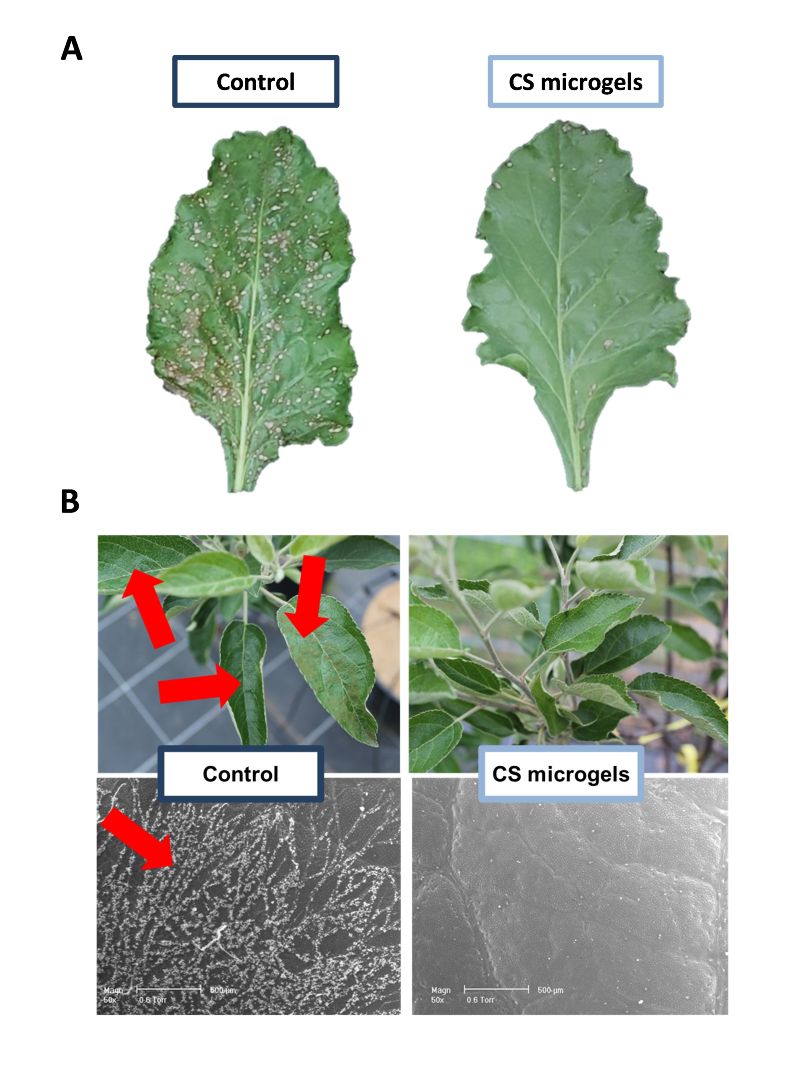
One focus of the development area “validation for sustainable agriculture” is to investigate the implementation of fungicides and herbicides in the greenRelease technology for a sustainable agriculture (CG Noga/Lüdeling, CG Conrath, CG Groth). To ensure the sustainability of the greenRelease technology, we investigated possible impacts on selected plants and microorganisms in both controlled and field conditions, evaluated the protective capacity of microgels incorporated copper ions and determined the provision of herbicides from functionalized microgels.
First, the binding of suitable anchor peptides and the combination of those with mircogels had to be confirmed on the surface of crops leaves, more specifically on apple and sugar beet. Using confocal laser scanning microscopy, we detected the fluorescence of eGFP, which was fused to the anchor peptides as a traceable marker. The analysis of treated crop leaves revealed, that anchor peptides were identified that bound the microgels to the leaf surface in a rainfast manner (Fig. 2). Moreover, electron microscopy revealed, that upon spraying them, the microgels distribute evenly in a homogenous layer on leaf surfaces. In addition, functionalized microgels with copper after spraying neither altered photosynthetic activity nor leaf growth, showing no phytotoxic effects on crop plants. However, since leaf surface wax microstructures and their compositions vary between crop species, their binding and distribution pattern may slightly differ in field environment.
Next, the plant protective capacity of the greenRelease technology was evaluated. We investigated the biological efficacy by artificial inoculation assays in the lab as well as in field experiments under natural conditions. The pre-treatments with copper loaded microgels significantly reduced the symptom formation of the pathogens Cercospora beticola (causing agent of Cercospora Leaf Spot in sugar beet, Beta vulgaris) and Venturia inaequalis (causing agent of Apple Scab in apple, Malus domestica). At controlled conditions in the greenhouse, very low concentrations of copper were sufficient to reduce the symptom formation of C. beticola on infected sugar beet (Fig. 3A). Moreover, copper-loaded microgels provided a similar or even better protection of sugar beet from Cercospora Leaf Spot compared to commercial products, even when the treatment was followed by a natural rainfall event. Compared to commercial products, copper-loaded microgels provided a similar or even better protection from Apple Scab at controlled conditions (Fig. 3 B) as well as in field trials. Thus, the field trials performed by the chamber of agriculture in an apple orchard demonstrated, that the amount of copper, which was necessary to prevent Apple Scab disease, could be reduced significantly (3-fold) to 0.7 kg Cu2+/ha*yr, when the greenRelease technology was used.



Besides reducing fungicides, the greenRelease technology is suited as a tool for the reduction of herbicides. To validate the potential of this technology for the implementation of herbicides, a benchmarking setup had to be established. Comparing the broad-spectrum herbicide Desmedipham and a novel C4-Photosynthesis specific herbicidal compound Okanin, we used photosynthetic activity of weed leaves (Amaranthus retroflexus) and crop leaves (Beta vulgaris), measured by infrared gas analytics, as a marker. The benchmarking platform revealed herbicidal activity for both compounds, while also validating the performance of our platform. In a final step the loading, release and weed growth inhibiting potential of the herbicide Okanin was evaluated, with the compound delivered to the plant by releasing it from microgels. First results show not only that herbicidal activity is present after successful release of Okanin, but also that the incorporation of the compound in microgels has a stabilizing effect on the active compound. Release and effectivity could even be further increased with the addition of a solvent to trigger release of the active compound (Fig. 4). This superior effect, compared to the active compound alone, is due to prolonged and controlled release from the greenRelease technology, resulting in more efficient herbicide delivery.
By testing microgels loaded with active ingredients, we could demonstrate the effectiveness of the technology to provide rainfast protection against two major fungal diseases. Furthermore, the greenRelease technology might serve as a tool for improved herbicide delivery.
Prof. U. Conrath
Dr. C. Langenbach
Dr. P. Schwinges
Institute of Plant Physiology
RWTH Aachen University
Prof. G. Groth
Dr. A. Hofmann
Biochemical Plant Physiology
HHU Düsseldorf Bioinformatics
HHU Düsseldorf
Prof. E. Lüdeling
Prof. Dr. G. Noga
Dr. Shyam Pariyar
INRES-Horticultural Sciences
Universität Bonn